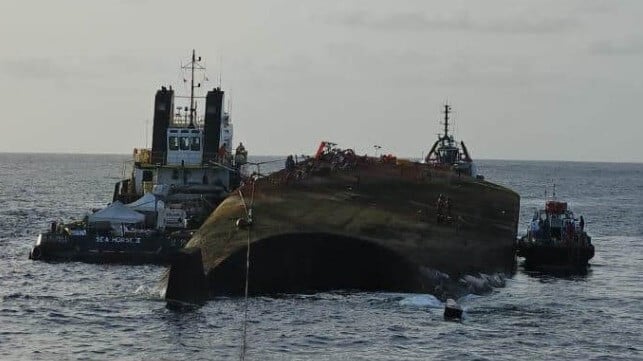Removal of Capsized Oil Barge off Tobago Completed After Six Months

The mysterious oil barge that overturned and was leaking oil off the coast of Tobago has finally been salvaged as the search for the culprits continues. Trinidad and Tobago’s Ministry of Energy and Energy Industries (TEMA) reported the successful refloating of the barge as the last step in the recovery efforts that are expected to cost as much as $30 million.
Refloating of the Gulfstream barge began yesterday afternoon, August 19, with the effort requiring approximately six hours. Shortly before midnight local time the salvage team confirmed the Gulfstream was afloat. T&T Salvage, which had been working with the ministry for months, oversaw the operation.
The barge was discovered by residents overturned and wedged on the west coast of Tobago on February 7 leaking oil. At first, the Coast Guard and local officials thought a cargo ship had capsized, but they were unable to locate any survivors. Further investigation revealed it was a large ocean-going oil barge that had been under tow by a tugboat, which could not be located.
T&T launched a containment and remediation effort requesting international assistance. The barge had a capacity of approximately 85,000 barrels. As of April, the teams reported that over 32,000 barrels had been recovered from the barge. A nine-mile section of the coastline was also covered with the oil while there had been fears it might also wash toward neighboring countries.
The salvage team had to postpone the planned removal operation which had been set for August 5 and 6. It was delayed by the rough surf and conditions created by tropical storm (later hurricane) Ernesto.

Salvage teams were securing the barge while divers began a survey (TEMA)
The barge was moved overnight to a position approximately three nautical miles off the coast with tugs managing the overturned wreck. Today, divers were beginning an underwater survey of the barge accessing areas that had been aground. They are also looking for hanging debris that needs to be removed before a tow can begin.
The plan is to take the barge from Tobago to Port-of-Spain, Trinidad. The towing operation is expected to take approximately 33 hours. It will be accompanied by a pollution response team on contingency vessels following the two tugs that will maneuver the overturned Gulfstream barge.
The Ministry of Energy and Energy Industries said the beach and coastal cleanup has been completed, and it was closing its temporary facility at Cove, Tobago.
The search continues for the crew of the tug that was operating the tow and which abandoned the barge. The tug went dark turning off its locator signal, but further analysis identified it was the Solo Creed, built in 1976 in the United States. It is 128 feet (39 meters) with 538 gross tons. Ownership is unclear as well as its registry. Most databases reflect it as the Ranger registered in Tanzania, but in most cases, the data is reported as old or the owners as unknown.
The tug turned up in Angola in May 2024 and the government of T&T was seeking help from the local authorities to detain the vessel and its crew. T&T’s Energy Minister had also said that they were asking for assistance from Panama, Aruba, Curacao, Tanzania, and Nigeria in the investigation into the vessel.
The International Pollution Fund recognized the claims made by Trinidad and Tobago. It was making up to $50 million available as compensation. It was to be used to assist in the cleanup and to provide compensation to those affected by the spill.
